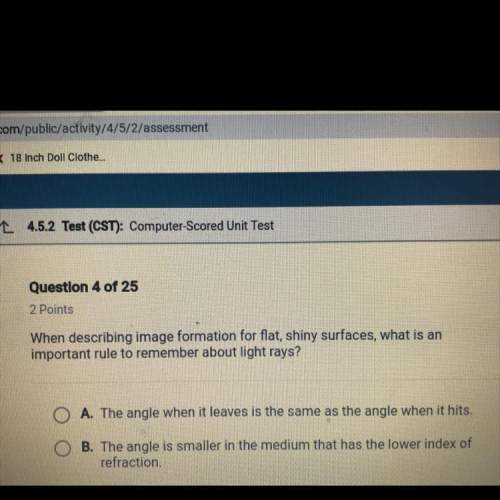
Physics, 17.12.2020 17:30 batmannn1516
If the ball has a mass of 2.00 kg and is moving at a velocity of 4.50 m/s at point B, what is the height of the hill at point D if the ball is still moving at 1.00 m/s? 4

Answers: 1
Another question on Physics

Physics, 22.06.2019 15:30
To understand the electric potential and electric field of a point charge in three dimensions consider a positive point charge q, located at the origin of three-dimensional space. throughout this problem, use k in place of 14? ? 0. part adue to symmetry, the electric field of a point charge at the origin must point from the origin.answer in one word.part bfind e(r), the magnitude of the electric field at distance r from the point charge q.express your answer in terms of r, k, and q. part cfind v(r), the electric potential at distance rfrom the point charge q.express your answer in terms of r, k, and q part dwhich of the following is the correct relationship between the magnitude of a radial electric field and its associated electric potential ? more than one answer may be correct for the particular case of a point charge at the origin, but you should choose the correct general relationship. a)e(r)=dv(r)drb)e(r)=v(r)rc)e(r)=? dv(r)drd)e(r)=? v(r)r
Answers: 2

Physics, 22.06.2019 17:00
In the future, people will only enjoy one sport: electrodisc. in this sport, you gain points when you cause metallic discs hovering on a field to exchange charge. you are an electrodisc player playing the popular four disc variant. the disks have charges of qa = −8.0 µc, qb = −2.0 µc, qc = +5.0 µc, and qd = +12.0 µc. (1) you bring two disks together and then separate them. you measure the resulting charge of these two disks and find that it is +5.0 µc per disk. which two disks did you bring together? (a) a and b (b) a and c (c)a and d (d)b and c(e) b and d (f) c and d. (2) you bring three disks together and then separate them. you measure the resulting charge of these three disks and find that it is +3.0 µc per disk. which three disks did you bring together? a, b, and c (a) a, b, and d (c) a, c, and d (d) b, c, and d. (3) given the resulting charge of each disk measured in (b) is +3.0 µc, how many electrons would you need to add to a disk of this charge to electrically neutralize it? electrons
Answers: 3

Physics, 22.06.2019 17:00
Simon is writing a story about an astronaut whose spacecraft has been boarded by space pirates. the astronaut has her lucky penny in her hand behind her back as the space pirates break into the control room. she has just locked the controls so that the ship is accelerating in the direction of the control room’s ceiling. simon wants the astronaut to use the penny to hit a button on the control panel to turn off the lights and escape. the button is located a short distance behind and below the astronaut’s hands. how should simon use the theory of relativity to describe what the astronaut must do in order to hit the button?
Answers: 1

Physics, 22.06.2019 19:20
The dipole moment of the water molecule (h2o) is 6.17x10^-30 c.m. consider a water molecule located at the origin whose dipole moment p points in the +x-direction. a chlorine ion ( of charge-1.60x10^-19c , is located at x=3.00x10^-9m . assume that is much larger than the separation d between the charges in the dipole, so that the approximate expression for the electric field along the dipole axis can be used. a) find the magnitude of the electric force that the water molecule exerts on the chlorine ion. b) what is the direction of the electric force. -x-direction or +x-direction c) is this force attractive or repulsive?
Answers: 1
You know the right answer?
If the ball has a mass of 2.00 kg and is moving at a velocity of 4.50 m/s at point B, what is the he...
Questions


Health, 14.01.2021 21:40


Mathematics, 14.01.2021 21:40


Mathematics, 14.01.2021 21:40

Mathematics, 14.01.2021 21:40



Mathematics, 14.01.2021 21:40



Social Studies, 14.01.2021 21:40




History, 14.01.2021 21:40

Mathematics, 14.01.2021 21:40





